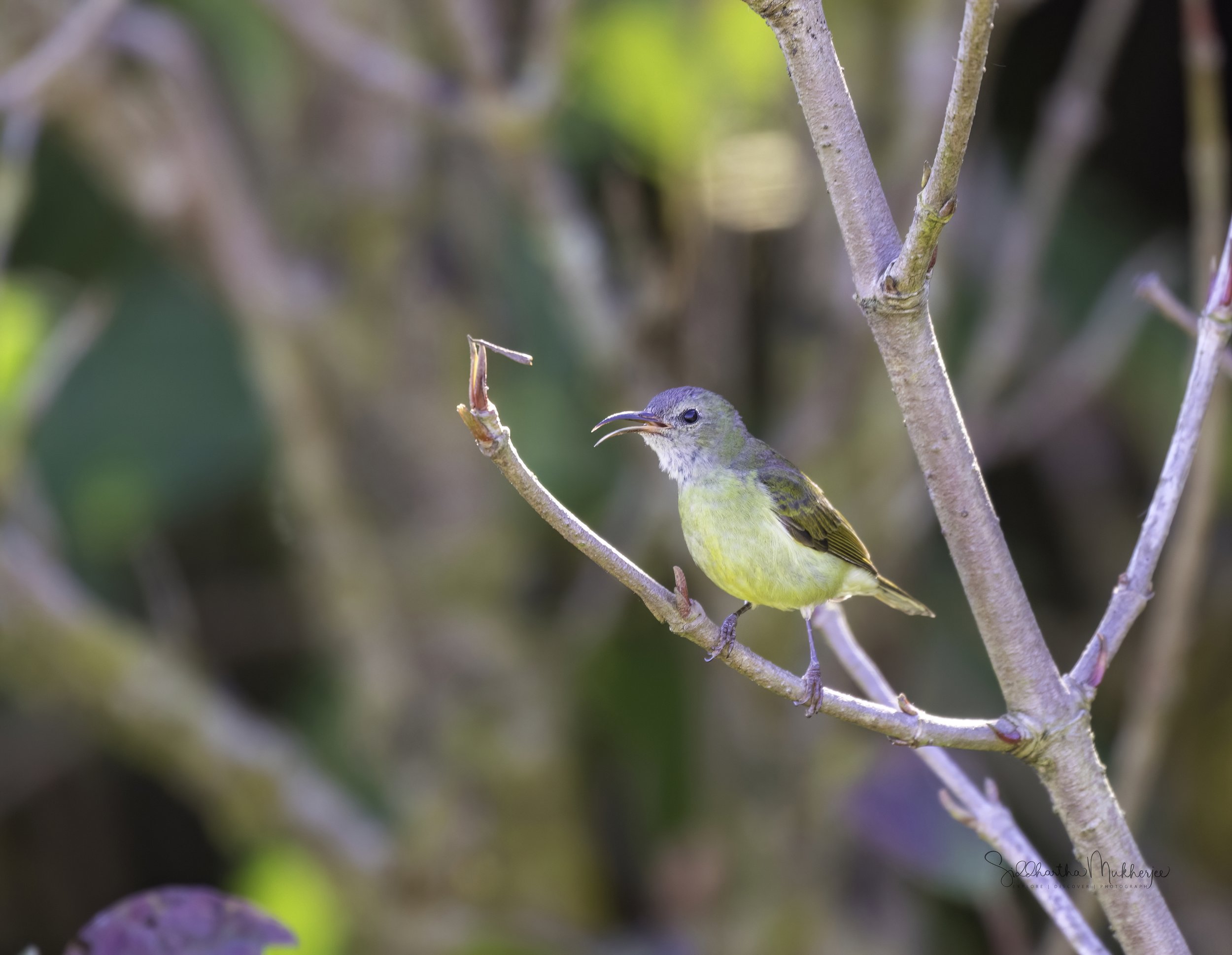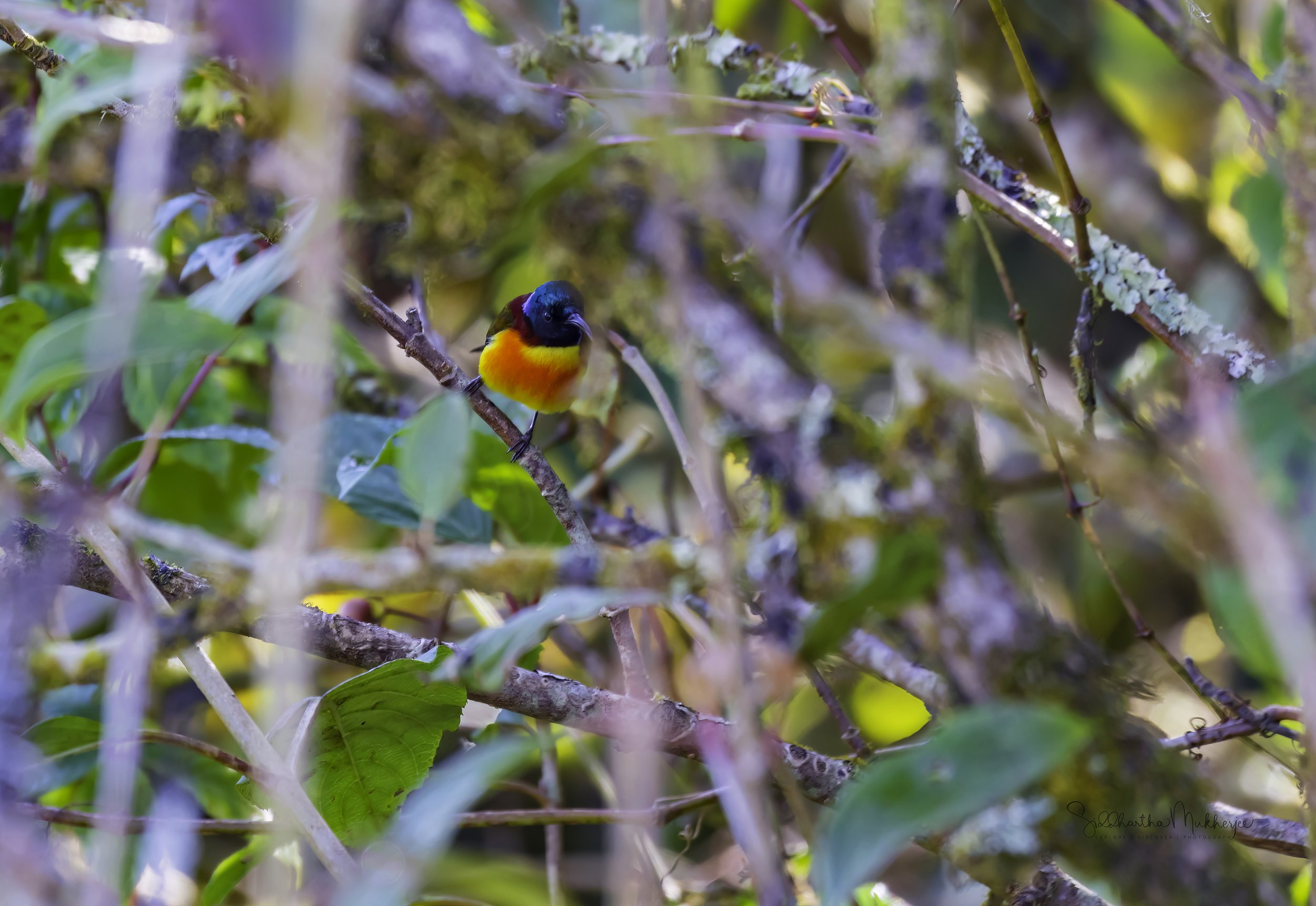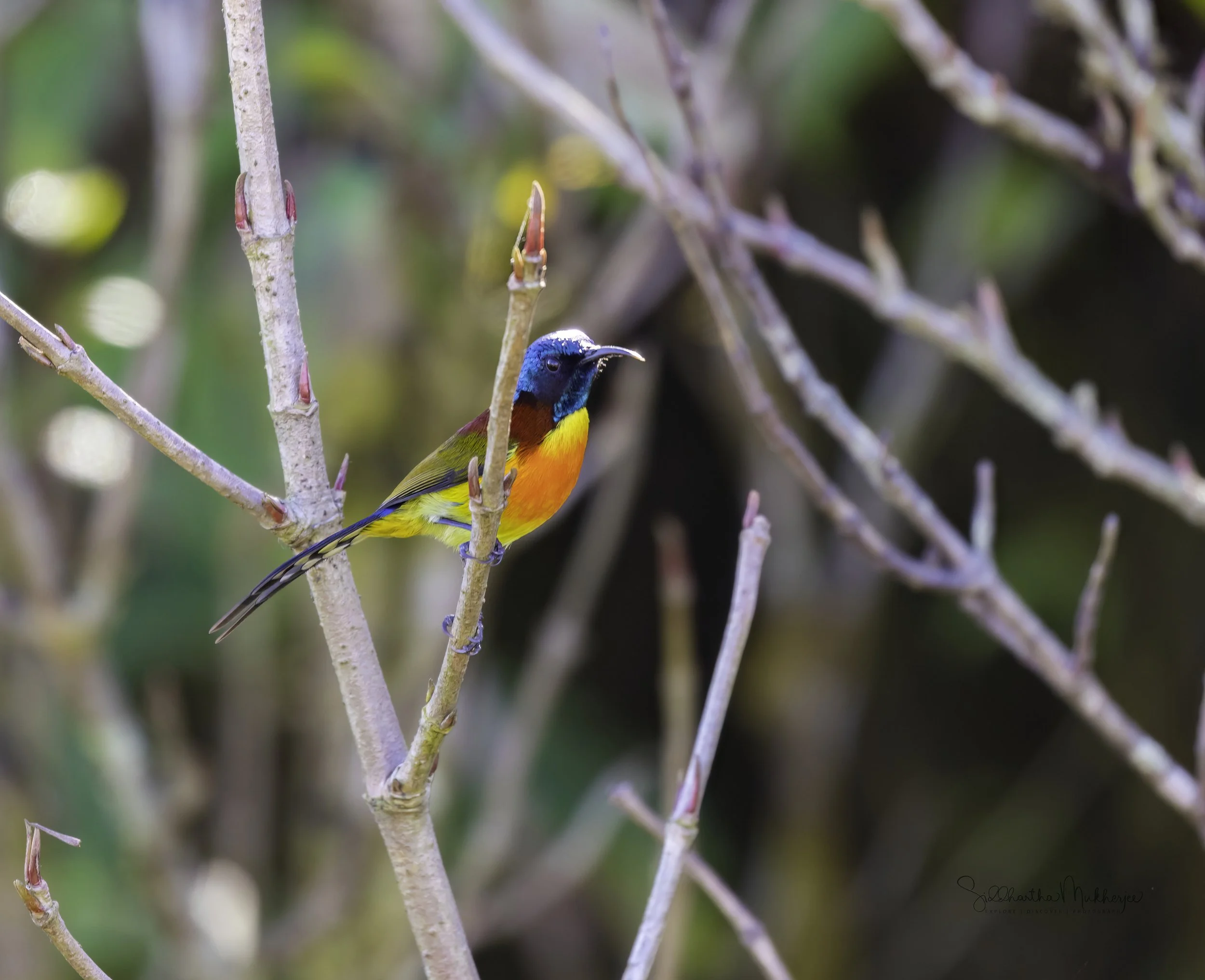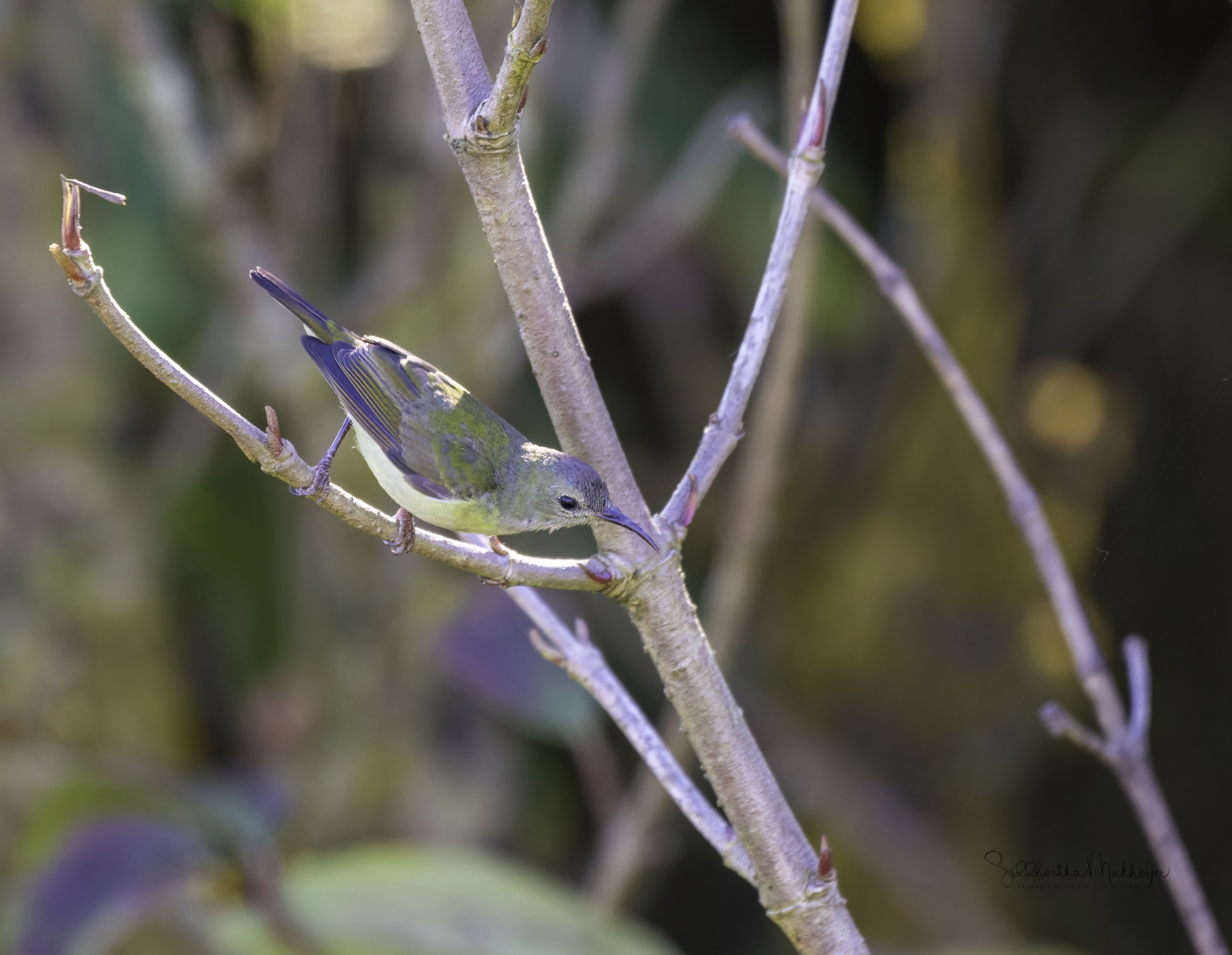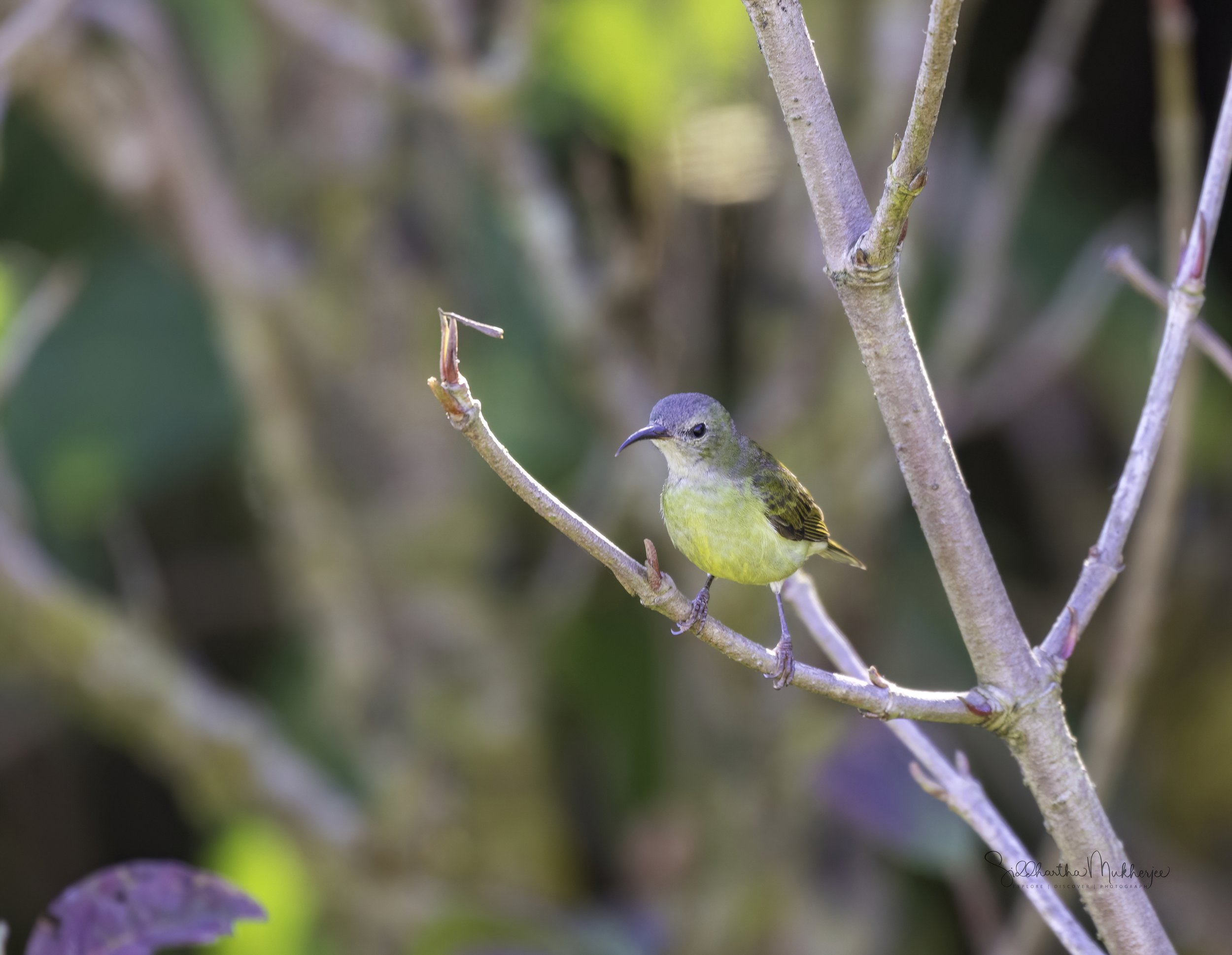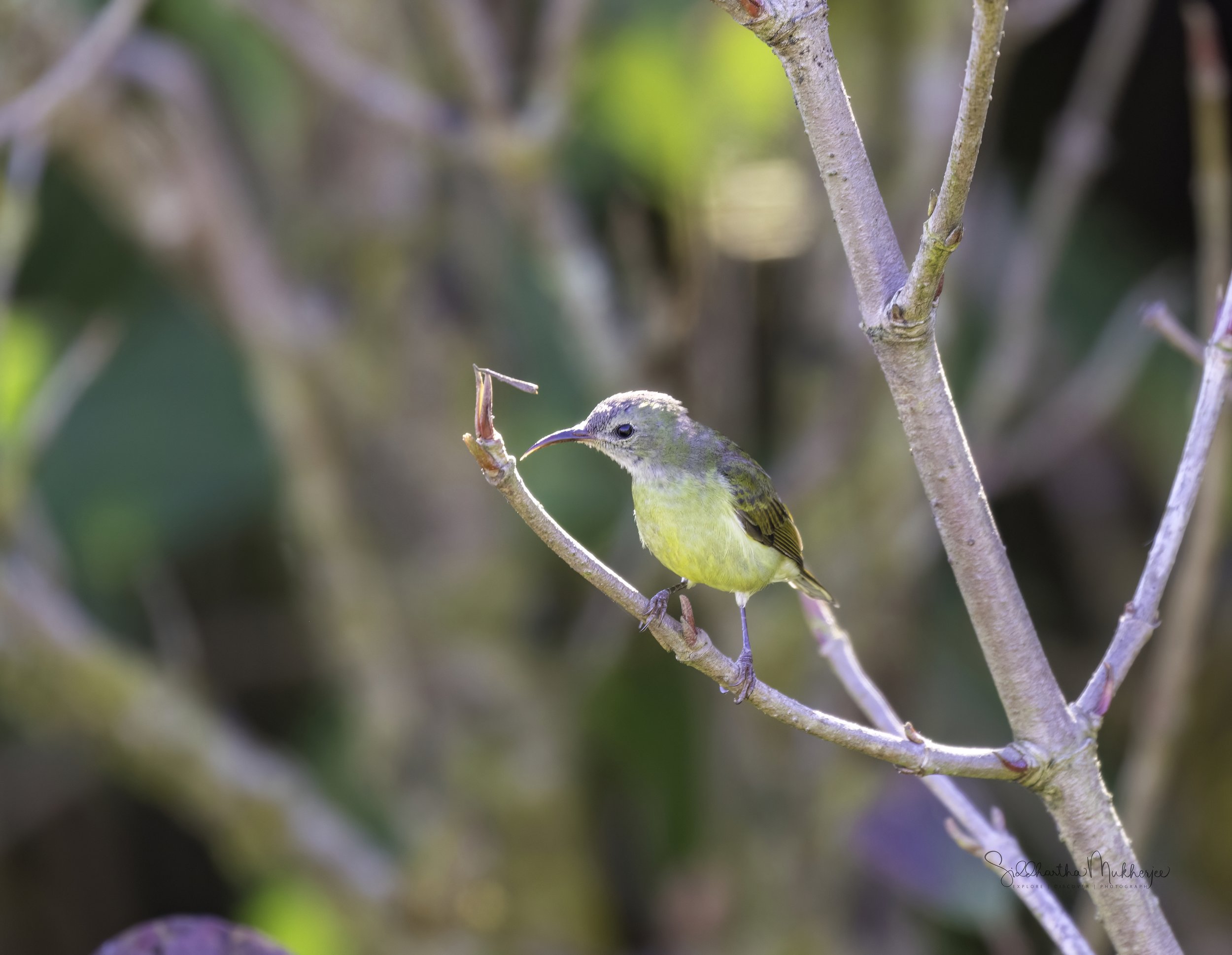Green-tailed Sunbird
Aethopyga nipalensis angkanensis
An endemic race of the Green-tailed Sunbird completely confined to the summit of Doi Inthanon.
Doi Inthanon Summit, Chiang Mai, Thailand
In early April I had written about the Birds on the Doi which was an overview of the four mountains in North Thailand and the abundant wild and bird life inhabiting them. Today I will talk about another one of the beautiful birds I have seen there - the Green-tailed Sunbird.
About 685 kilometers to the north of Bangkok lies the former seat of the ancient Lanna Kingdom and is considered one of the most scenic provinces in the country given its mountain ranges, valleys, flora and fauna. A land of misty mountains and colourful hill tribes, a playground for seasoned travellers, and a delight for adventurers. Despite its relatively small size and blissful calm, Chiang Mai truly has it all, a city that is still firmly Thai in its atmosphere and attitude. It is the second-largest changwat (province) of Thailand. Bordered by Chiang Rai to the northeast, Lampang and Lamphun to the south, Tak to the southwest, Mae Hong Son to the west and the Shan State of Myanmar to the north. Located in a verdant valley on the banks of the Ping River, Chiang Mai was founded in 1296 as the capital of the ancient Lanna Kingdom. Today it is a place where past and the present seamlessly merge with modern buildings standing side by side with venerable temples. Of all the places I have visited in Thailand, Chiang Mai with its forests and mountains and the historic city of Ayutthaya are by far my favourites.
Green-tailed Sunbird (Male)
The word Chiang itself is from North Thai, or Lanna, meaning town or city and Mai means new making Chiang Mai the New City as it was founded later than Chiang Rai, the earlier capital of King Meng Rai. The districts in the province are called amphoe, and sub-districts are called tambon. Another twist is the use of Nakhon (or Nakorn or Nakhorn), derived from the Sanskrit word Nagara, also means city, though strictly speaking it refers to a capital city such as Nakorn Sri Ayutthaya (more on Ayutthaya later). Indeed to emphasise its former status you may sometimes see Chiang Mai referred to as Nakhon Ping. Other common names of geographical features include mae (river) and doi which is north Thai for mountain - for example Doi Inthanon and Mae Ping.
The four Dois we spent our time on were Doi Inthanon, Doi Ang Khang, Doi Luang and Doi SanJu.
Doi Inthanon is Thailand’s highest mountain and a site of unique biological interest supporting a fascinating variety of vegetation and a higher bird species total than any other protected area. Of the total of 382 species of birds so far known from Doi Inthanon, at least 266 species are residents or were formerly residents on the mountain. Doi Inthanon is of particular conservation importance for those species which inhabit the moist hill evergreen forests of the upper slopes. Some, such as the Chestnut-tailed Minla and White-browed Shortwing, which are around the summit, occur in Thailand only on those few higher mountain summits which have considerable areas of hill evergreen forest above 1800 m. Doi Inthanon contains the only significant protected populations of such species in Thailand. The Ashy-throated Leaf-Warbler is found nowhere else in Thailand while an endemic race of the Green-tailed Sunbird (Aethopyga nipalensis angkanensis), the subject of our blog today, is also completely confined to the summit. The Wachirathan Waterfall is one of the best sites for observing birds of fast-flowing streams. The Plumbeous Redstart and the River Chat often perch on boulders in mid-stream. The Slaty-backed Forktail can sometimes be seen. Among the many scarce arboreal birds to look out for are the Long-tailed Broadbill, Brown-throated Treecreeper, Green Cochoa and Purple Cochoa and Black – tailed Crake.
We didn’t have the good fortune to see all the species on all the mountains, that would have been impossible, but we did rack up quite a number of species - about 95 of them.
For a print of this beautiful bird click on the button below to read my process and order a limited edition canvas.
‡‡‡‡‡
Green-tailed Sunbird (Female)
Green-tailed Sunbird
The Green-tailed Sunbird (Aethopyga nipalensis) or Nepal yellow-backed sunbird is a species of bird in the family Nectariniidae. Sunbirds and spiderhunters make up the family Nectariniidae of passerine birds. They are small, slender passerines from the Old World, usually with downward-curved bills. Many are brightly coloured, often with iridescent feathers, particularly in the males. Many species also have especially long tail feathers. Their range extends through most of Africa to the Middle East, South Asia, South-east Asia and southern China, to Indonesia, New Guinea and northern Australia. Species diversity is highest in equatorial regions.
There are 145 species in 16 genera. Most sunbirds feed largely on nectar, but will also eat insects and spiders, especially when feeding their young. Flowers that prevent access to their nectar because of their shape (for example, very long and narrow flowers) are simply punctured at the base near the nectaries, from which the birds sip the nectar. Fruit is also part of the diet of some species. Their flight is fast and direct, thanks to their short wings.
The sunbirds have counterparts in two very distantly related groups: the hummingbirds of the Americas and the honeyeaters of Australia. The resemblances are due to convergent evolution brought about by a similar nectar-feeding lifestyle. Some sunbird species can take nectar by hovering like a hummingbird, but they usually perch to feed.
The family ranges in size from the 5-gram black-bellied sunbird to the spectacled spiderhunter, at about 45 grams. Like the hummingbirds, sunbirds are strongly sexually dimorphic, with the males usually brilliantly plumaged in iridescent colours. In addition to this the tails of many species are longer in the males, and overall the males are larger. Sunbirds have long thin down-curved bills and brush-tipped tubular tongues, both adaptations to their nectar feeding. The spiderhunters, of the genus Arachnothera, are distinct in appearance from the other members of the family. They are typically larger than the other sunbirds, with drab brown plumage that is the same for both sexes, and long, down-curved beaks.
The genus Aethopyga has 22 species of which I have had the pleasure to photograph three - the Green-tailed Sunbird featured in this blog, the spectacular and jewel like Mrs. Gould's Sunbird & the Black-throated Sunbird which I will feature in a different blog.
Grey-hooded sunbird, Aethopyga primigenia
Apo sunbird, Aethopyga boltoni
Lina's sunbird, Aethopyga linaraborae
Flaming sunbird, Aethopyga flagrans
Maroon-naped sunbird, Aethopyga guimarasensis
Metallic-winged sunbird, Aethopyga pulcherrima
Luzon sunbird, Aethopyga jefferyi
Bohol sunbird, Aethopyga decorosa
Elegant sunbird, Aethopyga duyvenbodei
Lovely sunbird, Aethopyga shelleyi
Handsome sunbird, Aethopyga bella
Mrs. Gould's sunbird, Aethopyga gouldiae
Green-tailed sunbird, Aethopyga nipalensis
White-flanked sunbird, Aethopyga eximia
Fork-tailed sunbird, Aethopyga christinae
Black-throated sunbird, Aethopyga saturata
Crimson sunbird, Aethopyga siparaja
Magnificent sunbird, Aethopyga magnifica
Vigors's sunbird, Aethopyga vigorsii
Javan sunbird, Aethopyga mystacalis
Temminck's sunbird, Aethopyga temminckii
Fire-tailed sunbird, Aethopyga ignicauda
The Green-tailed Sunbird can be divided into the following subspecies based on the Geographic range.
Aethopyga nipalensis nipalensis: W Nepal to North Eastern India (Darjiling) and Sikkim
Aethopyga nipalensis koelzi: Himalayas (Bhutan to NE Myanmar, SW China and NW Tonkin)
Aethopyga nipalensis horsfieldi: W Himalayas (Garhwal to W Nepal)
Aethopyga nipalensis victoriae: W Myanmar (Chin Hills)
Aethopyga nipalensis karenensis: SE Myanmar (Karen Hills)
Aethopyga nipalensis australis: High mountains of south peninsular Thailand south of Isthmus of Kra
Aethopyga nipalensis blanci: High mountains of Laos
Aethopyga nipalensis ezrai: High mountains of s Vietnam
Aethopyga nipalensis angkanensis: High mountains of n Thailand specifically Doi Inthanon
The male Green-tailed Sunbird is about 14–15 cm long and weighs between 5·5–8 grams. The female is about 10 cm weighing between 5·4–6·5 g. It is a long tailed sunbird with a rather long, heavy-based curved bill. The male of the nominate race has crown, nape, uppertail-coverts and graduated tail in a metallic green to blue-green shade with a white-tipped tail visible from below and with elongated central feathers. The juvenile is similar to the female, but has a greener crown and is yellower below, with a less graduated tail with less obvious pale tips. For the endemic race featured here - Aethopyga nipalensis angkanensis - the male has its lower breast and upper belly scarlet. This geographically outlying race angkanensis is distinguished by its strong flame-red breast, slightly broader russet-chestnut back (“cape”) than the next best-marked taxon and in varying degrees by the strength of its yellow rump, shortness of its bill, brightness of its vent, etc., but in each of these it is matched by certain other taxa.
In metabolic behaviour similar to that of Andes hummingbirds, species of sunbirds that live at high altitudes or latitudes will enter torpor while roosting at night, lowering their body temperature and entering a state of low activity and responsiveness.
The moulting regimes of sunbirds are complex, being different in different species. Many species have no eclipse plumage, but do have juvenile plumage. Some species do show duller plumage in the off-season. In the dry months of June−August, male copper sunbirds and variable sunbirds lose much of their metallic sheen. In some instances different populations of the same species can display variation in different molting regimes.
Sunbirds are a tropical Old World family, with representatives in Africa, Asia and Australasia. In Africa they are found mostly in sub-Saharan Africa and Madagascar but are also distributed in Egypt. In Asia the group occurs along the coasts of the Red Sea as far north as Israel, and along the Mediterranean as far north as Beirut, with a gap in their distribution across inland Syria and Iraq, and resuming in Iran, from where the group occurs continuously as far as southern China and Indonesia. In Australasia the family occurs in New Guinea, north eastern Australia and the Solomon Islands. They are generally not found on oceanic islands, with the exception of the Seychelles. The greatest variety of species is found in Africa, where the group probably arose. Most species are sedentary or short-distance seasonal migrants. Sunbirds occur over the entire family's range, whereas the spiderhunters are restricted to Asia. The Green-tailed Sunbird is found in Nepal the northern regions of the Indian subcontinent, stretching eastwards into parts of Southeast Asia. The race of the Green-tailed Sunbird mentioned in this blog is endemic to and completely confined to the summit of Doi Inthanon.
These sunbirds and spiderhunters occupy a wide range of habitats, with a majority of species being found in primary rainforest, but other habitats used by the family including disturbed secondary forest, open woodland, open scrub and savannah, coastal scrub and alpine forest. Some species have readily adapted to human modified landscapes such as plantations, gardens and agricultural land. Many species are able to occupy a wide range of habitats from sea level to 4900 m. The Green-tailed Sunbird prefers temperate forests and subtropical or tropical moist montane forests. In southeast Szechwan and Yunnan, it lives in open mountain woods with moss-covered trees, from 1825 to 3350 meters elevation.
‡‡‡‡‡
Related Posts

